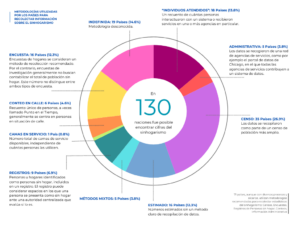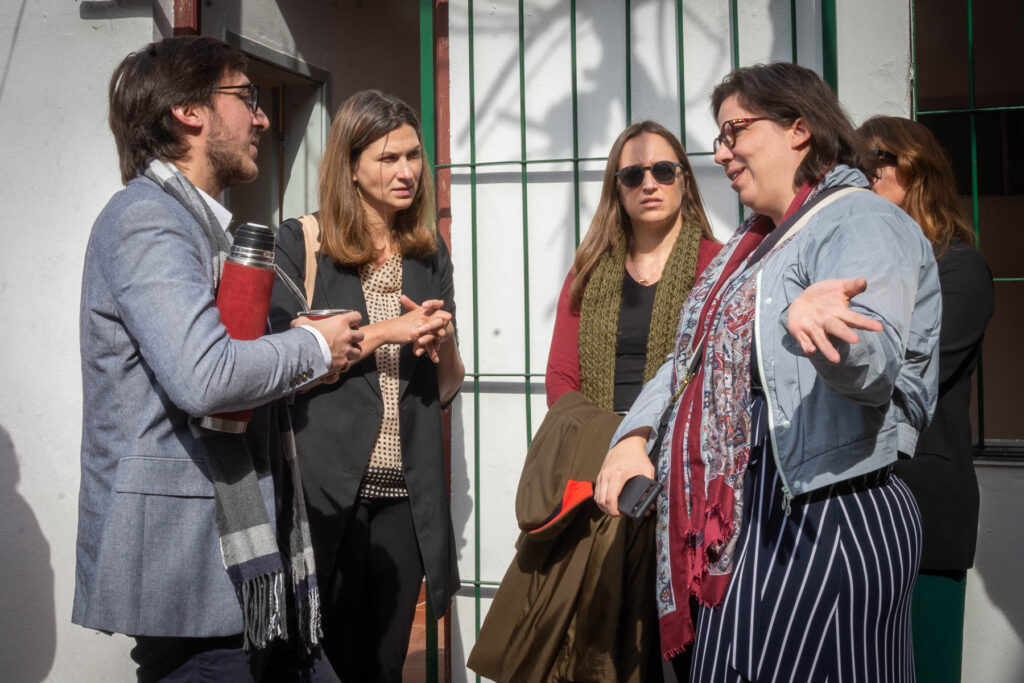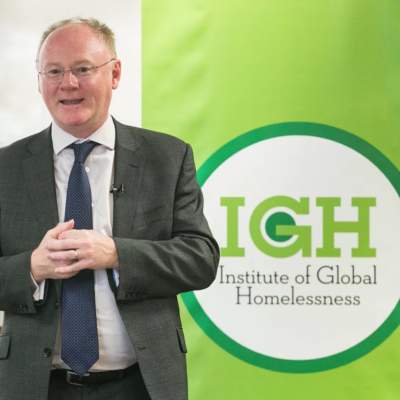El sinhogarismo es un fenómeno global que tiene incidencia en todo el mundo, aunque se manifiesta de diversas maneras según las circunstancias locales de cada país. Debido a la importancia de promover estadísticas precisas, el equipo del Instituto Global del Sinhogarismo (IGH) desarrolló el Global Homeless Data Map o Mapa de Datos Globales del Sinhogarismo. Las estadísticas compartidas se basan en una revisión global de todos los datos disponibles públicamente, pero reconocemos que son inexactas debido a lagunas en la recopilación de información, diferentes definiciones nacionales y problemas de precisión en muchos países. Por ello, el mapa del IGH tiene por objetivo compartir el estado actual de los datos del sinhogarismo y abogar para que los países establezcan definiciones estandarizadas y mejoren la recolección de datos para responder a la creciente crisis de las personas sin hogar.

Esta iniciativa consiste en una inspección de todos los datos disponibles públicamente en fuentes gubernamentales, organizaciones no gubernamentales, organizaciones intergubernamentales y artículos periodísticos en medios de comunicación. Los datos han sido compartidos a través de un mapa que incluye el número de personas experimentando el sinhogarismo en cada país, la definición de sinhogarismo utilizada, la metodología de recolección, el año de la estadística y la fuente de la información. El mapa fue actualizado por el equipo del IGH a inicios de 2024 para tener una visión actualizada de la situación global del sinhogarismo y promover acciones concretas y efectivas que contribuyan a eliminar este problema. El mapeo incluye información de todos los países con alguna fuente de datos en sinhogarismo, sin embargo, sólo 78 naciones han llevado a cabo procesos estadísticos oficiales.
Desde el inicio de este proyecto, el número de países que reporta estadísticas oficiales sobre el sinhogarismo ha aumentado. Al mismo tiempo, ha crecido la atención mundial sobre este problema con tres resoluciones de las Naciones Unidas sobre el sinhogarismo, el Informe del Secretario General de las Naciones Unidas sobre las personas en situación de calle y la Plataforma Europea de Lucha contra las Personas sin Hogar. La resolución de las Naciones Unidas adoptada por la Asamblea General en 2021, “exhorta a los Estados Miembros a que recopilen datos desglosados sobre la demografía relacionada con las personas sin hogar y establezcan categorías de personas en situación de sinhogarismo que acompañen a las herramientas de medición existentes y alienta a los Estados Miembros a que armonicen la medición y la recopilación de datos sobre las personas sin hogar para permitir la formulación de políticas nacionales y mundiales.” Aunque se ha incrementado la atención internacional sobre esta cuestión, las personas en situación de calle siguen estando ausentes de los 17 Objetivos de Desarrollo Sostenible (ODS) y de los 169 Indicadores de Naciones Unidas. El IGH está impulsando la inclusión del sinhogarismo en los ODS debido a la gravedad de este problema en todos los países del mundo. Las personas experimentando el sinhogarismo están aumentando a nivel mundial por la creciente urbanización, la crisis del coste de la vida, el desplazamiento y la migración, el cambio climático y los conflictos armados, y la falta de datos y de medidas específicas sobre las personas sin hogar amenaza el progreso mundial en la consecución de los ODS.
Los datos presentados por el mapa del IGH son las mejores estadísticas globales sobre el sinhogarismo disponibles en la actualidad, sin embargo, necesitamos que un mayor número de países recopilen información para que los datos sean más precisos. En un esfuerzo por dirigir la atención a la magnitud del problema del sinhogarismo, nuestro mapa comparte todas las estadísticas disponibles públicamente sobre personas sin hogar y destaca las diferencias en la calidad, transparencia, precisión y fiabilidad de los datos. Durante el proceso de revisión, identificamos que gran parte de los datos mundiales están desactualizados y no se recopilan siguiendo los estándares internacionales, por lo que en el mapa no comparamos entre países ni por incidencia (número de personas sin hogar por cada 10.000 habitantes). De igual forma, observamos que las definiciones varían ampliamente de un país a otro, lo que hace extremadamente difícil contabilizar el total de personas en situación de sinhogarismo. En algunos casos, el sinhogarismo refiere a personas que viven en la calle o carecen de un techo, otros países incluyen a quienes se albergan en alojamientos temporales y algunos utilizan una definición más amplia que abarca tanto las categorías anteriores, así como a las personas que comparten un mismo lugar de residencia, viven en alojamientos inseguros, en condiciones de hacinamiento o en estructuras no destinadas a vivienda humana. Esta última conceptualización es más integral de las distintas manifestaciones del sinhogarismo y se alinea con el marco de categorías y manifestaciones propuesto por el IGH en 2016, el que fue desarrollado en colaboración con investigadores, expertos en políticas y líderes de los seis continentes para ofrecer un lenguaje compartido que facilite la colaboración internacional, el entendimiento intercultural y la medición del sinhogarismo a nivel global.
Creemos que, en la lucha por erradicar el sinhogarismo de manera eficaz, es necesario que países y gobiernos trabajen en definiciones claras, estandarizadas e inclusivas que permitan recolectar información estadística certera y fiable. El IGH propuso un marco que combina la noción tradicional del sinhogarismo, la falta de vivienda adecuada, con otras formas de necesidades de vivienda y permite a los países y ciudades elegir según sus contextos locales. Pese a reconocer las diversas formas en que puede manifestarse el sinhogarismo, creemos que, sin definiciones estandarizadas y metodologías consistentes, las estadísticas actuales están incompletas y quienes diseñan políticas públicas carecen de la información adecuada para entender y atender la magnitud del problema. Por ejemplo, en un análisis que el IGH está realizando de la situación en América Latina y el Caribe fue posible observar que existe un foco predominante en la situación de calle, lo que limita las estrategias diseñadas para erradicar el sinhogarismo en su totalidad. Asimismo, las estadísticas, en muchos países inexistentes, tienden a ser recopiladas siguiendo esta definición y se enumera casi exclusivamente a quienes viven en las calles o albergues temporales a través de métodos como conteos nocturnos, los que han sido cuestionados por su baja fiabilidad. En ese contexto, el objetivo de la visualización de datos en este mapa es demostrar los problemas de los datos; además de dónde y cómo los países pueden alinearse en cuanto a la definición y las metodologías, mejorando con el tiempo.

Reconocemos la necesidad de priorizar la recolección de buenos datos por sobre la búsqueda de estadísticas perfectas. Con buenos datos, nos referimos a información relevante, actualizada y de amplio alcance recopilada a través de metodologías válidas y alineadas bajo una definición integral y detallada de la falta de vivienda. Los datos sobre el sinhogarismo deben ser accesibles, actualizarse constantemente para reflejar la situación actual de cada país/región y estar estandarizados en todo el conjunto de datos para garantizar la coherencia y fiabilidad de la información obtenida. Las estadísticas de este mapa no siguen los estándares de calidad o precisión esperados, pero hacemos un llamado a mejorar los procesos estadísticos para rastrear la extensión de este problema, tomar decisiones informadas y desarrollar estrategias que aborden los elementos multidimensionales e interseccionales que causan la falta de vivienda.












 After each flight test, they will be given 5 minutes to experiment with a new design. Then they will go back to the starting point and take off again, hoping for an improved flight process and a longer landing. Ask anyone in the homelessness sector and they will tell you that change often happens in the form of small experiments that eventually lead to a breakthrough.
After each flight test, they will be given 5 minutes to experiment with a new design. Then they will go back to the starting point and take off again, hoping for an improved flight process and a longer landing. Ask anyone in the homelessness sector and they will tell you that change often happens in the form of small experiments that eventually lead to a breakthrough. What if you could make something totally new? What if you could take a long, hard look at your homelessness services, bring in the perspectives of a wide range of users and stakeholders in the community, and come up with something that transforms an incremental system into a breakthrough system?
What if you could make something totally new? What if you could take a long, hard look at your homelessness services, bring in the perspectives of a wide range of users and stakeholders in the community, and come up with something that transforms an incremental system into a breakthrough system?










